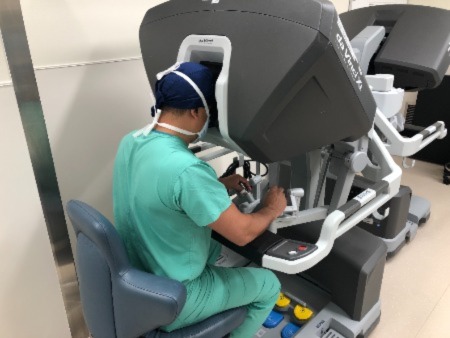Interventional Pulmonology celebrates 100th robotic-assisted bronchoscopy procedure
UC Davis Medical Center is first in the Sacramento region to reach this milestone
UC Davis Medical Center has completed its 100th robotic-assisted bronchoscopy procedure for minimally invasive peripheral lung biopsy, becoming the first hospital in the Sacramento region to reach this milestone.

The renown academic medical center was the first in the University of California Health system to combine this technology using a fully robotic approach to remove lung cancer at the earliest stages — when treatment is most effective.
“With lung cancer being the leading cause of cancer deaths among both women and men, UC Davis Health is proud to offer minimally invasive options like robotic-assisted bronchoscopy to provide diagnosis to treatment in a single-anesthesia procedure,” said Chinh Phan, director of the UC Davis Interventional Pulmonology Program. “Lung cancer is a malignancy that can spread quickly, shows no symptoms unless it is very advanced, and can silently spread to virtually any part of the body. This makes early screening, diagnosis and treatment critical.”
The Interventional Pulmonology Program performed its first robotic-assisted bronchoscopy procedure just eight months prior to reaching this milestone. Biopsies of cancerous lung nodules can be the most challenging as more than 70% of these nodules are located in the difficult-to-reach peripheral lung.

The robotic-assisted bronchoscopy procedure utilizes the Ion Endoluminal Platform by Intuitive. The high-tech system creates a 3D map of the patient’s lungs using a CT scan. The software then generates the safest and most efficient route through the lung to the nodule or mass. Once the route is determined, an ultrathin and ultra-maneuverable catheter reaches the lung nodule or mass, where it is biopsied with precision and stability.
The samples are then evaluated on-site. If the lung nodule is determined to be an early-stage cancer, the surgical team uses the same navigational route to mark the area with dye and prepare for its removal. Then, the patient, still asleep, has a second robotic procedure to remove the lung cancer on the same day.
“UC Davis Health is now capable of effectively detecting, diagnosing and curing lung cancer within 24 hours and that is a tremendous advantage for our patients,” Phan said. “Waiting months between a biopsy and a diagnosis can be an emotionally difficult and exhausting experience for patients. Fortunately, our innovative robotic-assisted bronchoscopy procedure minimizes these inefficiencies in the patient’s healthcare journey.”





